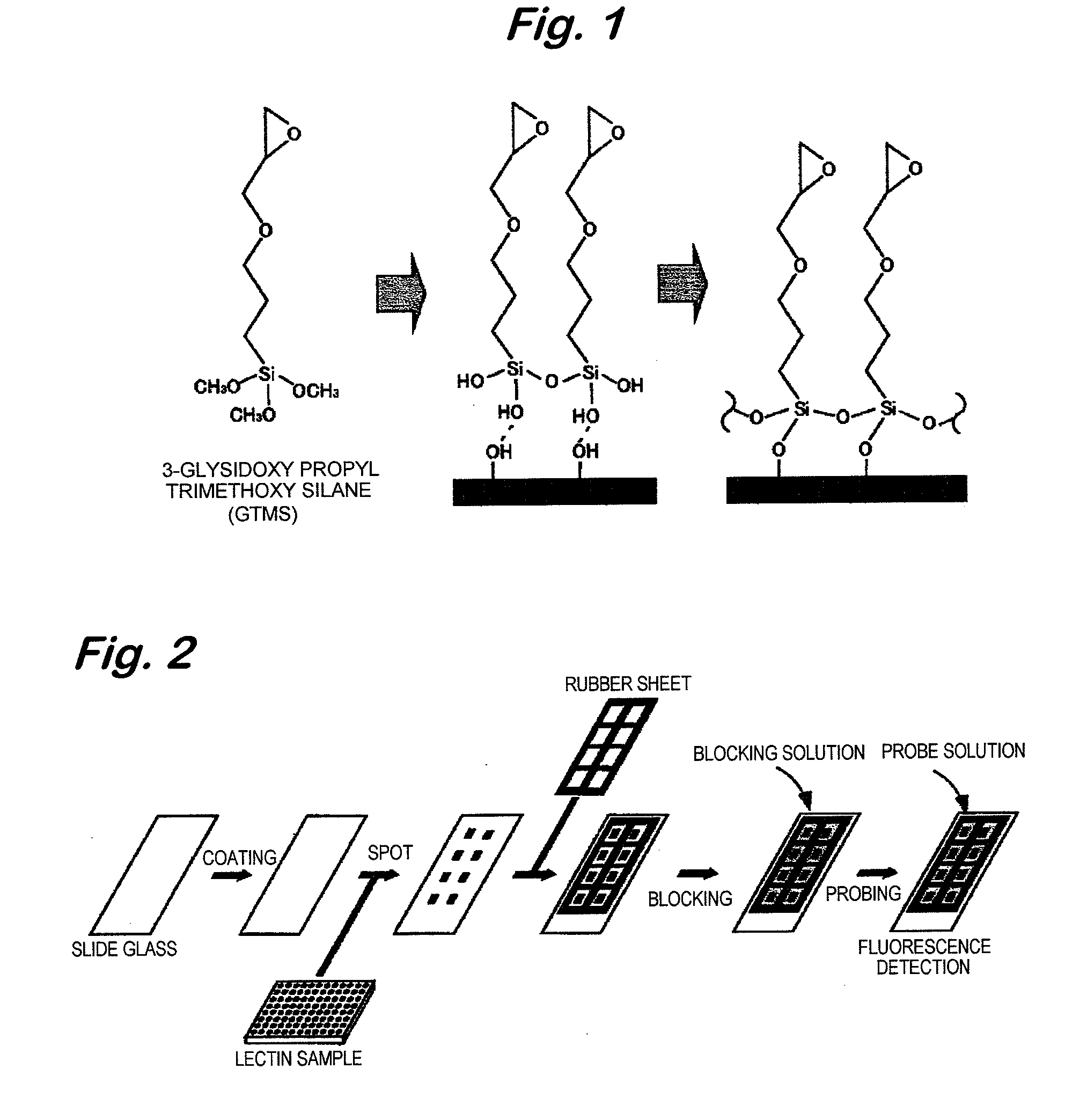Analyzer for glycan or complex carbohydrate
a technology of complex carbohydrate and analyzer, which is applied in the direction of fluorescence/phosphorescence, analysis by material excitation, instruments, etc., can solve the problems of large delay in the development and popularization of the protein micro-array, the inability to obtain accurate interaction information under the equilibrium state, and the inability to dissociate the probe molecules easily. , to achieve the effect of improving the accuracy of the feature and increasing the density
- Summary
- Abstract
- Description
- Claims
- Application Information
AI Technical Summary
Benefits of technology
Problems solved by technology
Method used
Image
Examples
example 1
Analysis for Interaction Between a Glycan and a Lectin Utilizing a Lectin Array
(1) Preparation of Fluorescence-Labeled Glycan Protein Probe (Cy3-ASF)
[0109]A fluorescence-labeled glycoside protein probe was prepared by fluorescence-labeling Asialo-Fetuin (manufactured by SIGMA Co. hereinafter referred to as ASF) using Cy3 Mono-reactive Dye (manufactured by Amersham Pharmacia Biotech Co. hereinafter referred to as Cy3) as a fluorescent dye having an absorption maximum wavelength near 550 nm. It is known that ASF has a glycan structure having an N-binding type glycan and an O-binding type glycan each by the number of 3 in the molecular and in which sialic acid cap at the non-reducing terminal in the glycan is partially detached. After preparing ASF to a final concentration of 1 mg / mL in a 0.1 M carbonate buffer (pH 9.3), it was mixed with 1.0 mg of a Cy3 powder per 1 mL, which was reacted in a dark place for 1 hour under optional stirring.
[0110]Then, free Cy3 and Cy3-ASF were recovered...
example 2
Analysis by Hybrid Array Spotting Lectin-Antibody in one Identical Compartment (FIG. 16)
1. Material and Method
(1) Preparation of Fluorescence Labeled Probe of Model Glycoside Protein
[0131]In this experimental example, as lectins to be immobilized on a lectin array, 6 types (RCA120, ECA, ConA, GNA, SSA, SNA) were selected as lectins having various glycan binding specificity. Further, BSA as a protein not binding with the glycan was selected as a negative control. Further, in this experiment, two types of anti-fetuin antibody and anti-RNase antibody recognizing the core protein portion of the probe were spotted in a compartment identical with that of the lectin. GNA and SNA purchased from VECTOR Co., BSA purchased from SIGMA Co., and RCA120, ECA, ConA, SSA purchased from Biochemical Industry were used.
[0132]A model fluorescence-labeled glycoside protein probe was prepared by fluorescence-labeling ASF, FET, ribonuclease B (RNase B) derived from bovine pancreas, and ribonuclease A (RNas...
example 3
Inhibitory Concentration Analysis Using Lectin Array (FIG. 17)
1. Material and Method
[0145]For confirming that the binding between lectin and probe molecules observed in the experiment was specific binding by way of the glycan, an inhibitive experiment using a competitive inhibitory glycan was conducted. In the experiment (A), RCA 120 was spotted in eight reaction vessels on a slide glass to constitute an array, then 8 types of ASF probe solutions with the concentration of a competitive inhibitory glycan (lactose) being changed were contacted simultaneously to observe the inhibition for the binding reaction (FIG. 17A). In the experiment (B), using ConA as the immobilizing lectin, using RNase B as the probe, and using mannose as the competitive inhibitory glycan, inhibition for the binding was observed by the same procedures (FIG. 17B). Since the materials and the procedures required for manufacturing the array were identical with those in the Example 2, descriptions therefor are to b...
PUM
| Property | Measurement | Unit |
|---|---|---|
| dissociation constant | aaaaa | aaaaa |
| thickness | aaaaa | aaaaa |
| excitation wavelength | aaaaa | aaaaa |
Abstract
Description
Claims
Application Information
 Login to View More
Login to View More - R&D
- Intellectual Property
- Life Sciences
- Materials
- Tech Scout
- Unparalleled Data Quality
- Higher Quality Content
- 60% Fewer Hallucinations
Browse by: Latest US Patents, China's latest patents, Technical Efficacy Thesaurus, Application Domain, Technology Topic, Popular Technical Reports.
© 2025 PatSnap. All rights reserved.Legal|Privacy policy|Modern Slavery Act Transparency Statement|Sitemap|About US| Contact US: help@patsnap.com



